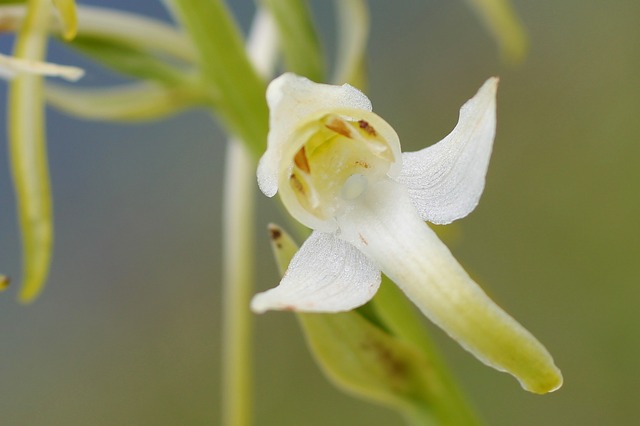 |  |  |  |  |
 |  |  |
Lesser Butterfly-orchid is a perennial plant, 25-50 cm tall (rarely up to 60 cm), with a pear-shaped gum. Root leaves 2. Leaves wide, oblong-shaped with a blunt tip. The stem is erect, without leaves, spikes at the end in an inflorescence. Flowers zygomorphic, yellowish white. Petals short. The legs are thin and long. Lip entire, tongue-shaped, anthers parallel, contiguous, their ligament narrow. The fruit is a box. Lots of seeds, small ones. The plant reproduces by seeds that are spread by the wind. The plant blooms in 6-7 years of life, at the beginning of summer, June-July. Pollination is provided by moths, which react to the strong smell of the plant. The seeds ripen in July-August.
The gums of wild plants are used for medicinal purposes. Gums are dug at the end of flowering or after the plant has finished flowering. Only the young, juicy gums are selected, they are cleaned from the soil, rinsed in running water. The rubbers are placed in boiling water for 2-3 minutes, then dried in a well-ventilated and shaded place or in forced dryers at a temperature not exceeding 50C. Dry gums are very hard, horn-like. The drug is stored in paper bags in a dry place.
The chemical composition of the Lesser Butterfly-orchid has been insufficiently studied. The gums of the plant contain a lot of mucilage <50% (including mannan), solids ~27%, sugar, proteins, mineral salts, essential oils, a small amount of calcium oxalic acid and other valuable substances.
Medicinal significance
Lesser Butterfly-orchid preparations have covering, strengthening, anti-toxic, tonic, anti-inflammatory, softening properties. Antiseptic, hypotensive and diuretic properties have also been observed, the plant helps to lower blood pressure. The medicinal properties are mainly provided by the mucilage substances in the plant, which protect the mucous membranes of the digestive tract, preventing them from being irritated and absorbing toxins. The gums of the plant have the ability to increase sexual activity, which is important for the treatment of impotence.
Lesser Butterfly-orchid is a well-known plant in folk medicine since ancient times. Folk scientists mainly use the gums of the plant, preparing various preparations from them (powders, slimy decoctions and ointments). Preparations are widely used in the treatment of various health problems. As a body-strengthening, mucous-coating, anti-inflammatory, tonic agent.
A decoction of the plant's gums is used to treat diseases of the digestive tract, fever, female line, constipation, poison poisoning, diarrhea, inflammation of the bladder, nervous exhaustion, convulsions and paralysis. In addition, gum decoctions are used to strengthen the activity of the gonads, prevent sexual weakness.
Gum powder is used to prevent diarrhea caused by various causes, including dysentery, intestinal catarrh, cystitis, infirmity of old age, prolonged bleeding and anemia caused by it. Fresh gums, cut into slices, are placed on painful teeth.
A decoction of the powder is used to treat diseases of the upper respiratory tract and oral cavity. A drink is also made from the gums of the plant, which is mixed with honey and used to treat coughs.
In folk medicine, crushed and steamed gums are mixed with honey or lard and used as an ointment to treat carbuncles, panaritis and suppuration. This ointment is also used to improve hair growth.
Folk scientists recommend using Lesser Butterfly-orchid gum for people in old age, to maintain strength, after serious illnesses, long-term bleeding and in case of dystrophy, to restore strength.
The powder from the old gums of the mother plant is used as a contraceptive, but you should know that with long-term use of such a product, women can also become infertile.
Evening primrose gum is also used to treat leukemia. For such purposes, the plant is mixed with field blackthorn and spotted hornwort in equal parts.